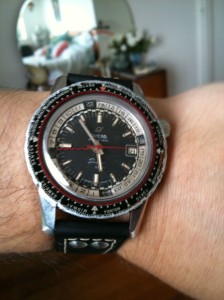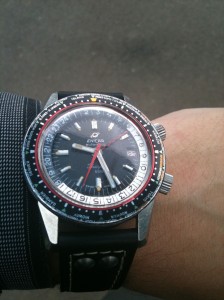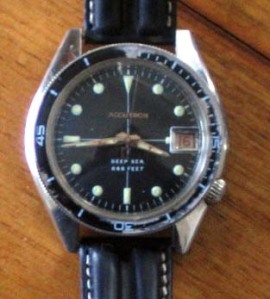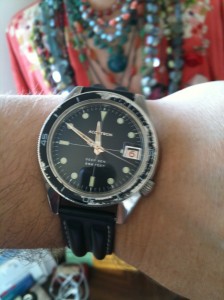I actually have two of these. Both date from 1969, but they have subtly different dials and inner bezels. And neither of them works properly … soon I’ll hand them over to an acquaintance who is a highly trained, professional watchmaker currently working for ‘a major Swiss brand’ who isn’t meant to moonlight but who likes to take on ‘challenging projects’ from his friends to do in his spare time. With luck, he’ll be able to make me one good, fully functional one from the two, and I’ll probably then sell on the remaining bits to some brave soul!
 This is the first one: it has a non-original sweep second hand, but the inner 24-hour bezel works perfectly and the red and black checkered 24-hour hand is also there and operational. The case is in very good shape (although the back has been over-polished and has lost some detail). The outer ‘world cities’ bezels on these are made of soft aluminium and are almost always damaged: this one is is so-so condition.
This is the first one: it has a non-original sweep second hand, but the inner 24-hour bezel works perfectly and the red and black checkered 24-hour hand is also there and operational. The case is in very good shape (although the back has been over-polished and has lost some detail). The outer ‘world cities’ bezels on these are made of soft aluminium and are almost always damaged: this one is is so-so condition.
Unfortunately, after running well for a few weeks I noticed that this watch had a tendency to stop overnight, usually a few hours after the date change-over. I got into the habit of re-setting it in the morning, but one day I went to set it and it had really seized up just before midnight, to the extent that when I stupidly tried to force it a little, the setting crown came out of the watch altogether! I could slip it back in and it would wind the movement, but not set the time. I took it to a watchmaker with a good reputation for repairs and restoration, but his verdict was that it was beyond economic repair.
 This is Enicar #2. As you can see, it has a slightly different, plainer dial and inner bezel. Overall, it’s in very good condition. All hands are correct. The movement runs strongly and keeps pretty good time. However, the 24-hour hand doesn’t run properly and the date changes over at about 8pm rather than midnight, so something is awry there; and the inner bezel is jammed and the upper crown mechanism (which turns the inner bezel) is broken (I’ve just stuck the crown from watch #1 over the end of the crown tube so it looks complete). The case-back still has all its detail, but its ‘Super Compressor’ mechanism doesn’t seem to lock into place the way it should, so the back is always slightly loose (which makes the ‘666 feet’ waterproof rating pretty useless!). The outer bezel on this one is in better condition — you can still see its orange highlights — but the little pointer on the red anodised inner ring has broken off.
This is Enicar #2. As you can see, it has a slightly different, plainer dial and inner bezel. Overall, it’s in very good condition. All hands are correct. The movement runs strongly and keeps pretty good time. However, the 24-hour hand doesn’t run properly and the date changes over at about 8pm rather than midnight, so something is awry there; and the inner bezel is jammed and the upper crown mechanism (which turns the inner bezel) is broken (I’ve just stuck the crown from watch #1 over the end of the crown tube so it looks complete). The case-back still has all its detail, but its ‘Super Compressor’ mechanism doesn’t seem to lock into place the way it should, so the back is always slightly loose (which makes the ‘666 feet’ waterproof rating pretty useless!). The outer bezel on this one is in better condition — you can still see its orange highlights — but the little pointer on the red anodised inner ring has broken off.



 Posted by timswatches
Posted by timswatches 


